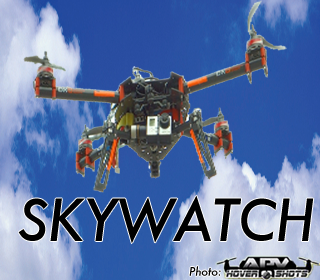
A group of Northwestern Michigan College students and instructors pose with the program’s fixed-wing drones. (Photo: Northwestern Michigan College)
Great Lakes Echo
The U.S. government isn’t expected to open airspace for civilian unmanned drone flight until 2015.
But Northwestern Michigan College students can fly drones today.
The Traverse City college is the only school in the Great Lakes region and one of a handful in the nation with federal approval to teach courses on unmanned aerial vehicles, more commonly known as drones. The college teaches U.S. drone law, drone technology and how to operate the school’s unmanned fixed-wing airplanes and quadcopters – helicopter-like unmanned aircraft with four rotors.
It also has a certificate of authorization from the Federal Aviation Administration (FAA), which permits the college and its students to research and conduct unmanned, outdoor flight with a number of remote control aircraft.
The decision to aggressively pursue an unmanned aerial vehicle program began about five years ago, said Tony Sauerbrey, the program’s manager.
“We were reading the writing on the wall how unmanned aerial vehicles and the whole industry in general is probably going to be playing a pretty large part of civilian aviation in the future,” he said.

This story is part of Great Lakes Echo’s ‘Skywatch’ series (UAV Photo: APV Hovershots)
The college prepares its students for operation of a drone in different settings, including commercial flight, said Sauerbrey. He believes the application of unmanned flight is possible in a large number of areas, from monitoring farmers’ fields to police surveillance to power line or pipeline inspection.
But the program has a problem: The use of drones in the United States is not legal for commercial ventures. So students who want to fly one as an occupation cannot do so unless they’re employed by the government or find work in another country.
College officials expect that to change in 2015 when the FAA is expected to announce regulations for civilians to fly the aircraft for profit. In fact, the college has helped the agency draft operator guidelines, according to the school’s website.
Sauerbrey anticipates the school’s program will meet FAA rules when they’re established. But he is also concerned the Congress won’t get to the issue by the deadline.
“There is a chance bureaucratic issues could delay that process,” he said.
“The regulations for small (unmanned vehicles) were actually supposed to be out about a year ago with sort of everything being figured out by 2015,” he said. “I’m hopeful that no matter what, no later than 2015 we’ll see those regulations in place, because it is really holding back an industry in a time when we need jobs.”
Despite the uncertainty regarding future drone law, the college’s aviation program has seen a drastic increase in student interest in unmanned flight, according to Aaron Cook, the program’s aviation director.
“Two years ago, 20 percent of inquiries into the aviation program were for the (unmanned vehicle) program, and last year it was 70 percent,” he said. “The interest has grown dramatically.”

A quadcopter in action. (Photo: Northwestern Michigan College)
Out of the school’s 120 aviation students, about half are enrolled in a drone class.
Northwestern Michigan College is unique because most schools in the nation can’t let students fly outside. To do that, they must apply for a certificate of authorization, but it is a time consuming process that requires a suitable flying environment, approval from the government and backing from the institution, said Cook.
“We have a flying field that was essentially donated to us so we had that resource available,” he said. “And we had an environment within the college that supported doing this. The idea of innovation and change and trying new things was supported here.”
Another big challenge is working with the government to get authorization, Sauerbrey said.
“You don’t just sign up online real quick and two days later you get (authorization),” he said. “They do want a lot of information on what you’re doing, where you’re flying, what you’re flying, the qualifications of the pilots, the training involved, and all that kind of good stuff. So they do want quite a bit of information, and that makes sense.”
Now that the college’s aviation program is established, the next big step will be whenever the FAA relaxes its restrictions on commercial use. When that happens, the students will see many immediate opportunities in the U.S, said Cook.
He lists golf course development, real estate photography and land surveys as just a few of the possible applications. But Cook said the technology has potential to take the field to places they could never anticipate right now.
“(Drones) today are the (cell) phones of the ‘80s,” he said. “Now, if you look at the iPhones of today, that’s where (the field) is going,” he said. “So while we’re talking about applications today, we can’t imagine in 10 years what these things will be used for.”
